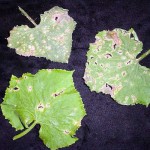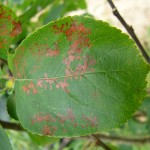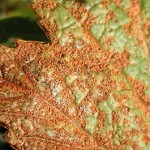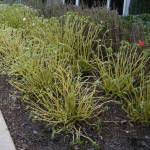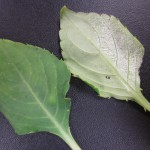The spring of 2013 was drastically different to the previous spring. Plants flowered almost a month later and cool, wet conditions were much more prevalent. As a result, many plants have been either infected with diseases they don’t normally suffer or have been infected with a typical disease to a much greater extent than normal. The following is the Spring 2013 Plant Disease Update.
Anthracnose
Many large shade trees were afflicted with anthracnose this spring. Anthracnose is particularly severe in wet weather, of which we had plenty. Common trees that can be attacked are sycamore, maple, beech, ash, and walnut. The damage is usually seen as irregularly shaped spots, which can cause the leaves to be curled, misshaped, and drop prematurely. New leaves are usually attacked and older leaves are more resistant. A new flush of growth will usually outgrow the disease. In severe cases, branch dieback and canker can occur. Although unsightly, anthracnose rarely harms the health of the tree and treatment is not usually necessary.
Scab
Scab is usually always an issue for crabapples, but in wet years it can be even more severe. The longer the leaf surface stays wet, the greater the possibility for infection of the leaf. Scab can be seen as small lesions on the leaf surface. Severely infected leaves may fall prematurely, and in extreme cases may cause defoliation of the tree by summer. To prevent this disease, fungicide applications should be applied as new growth emerges in spring and repeated periodically as fungicide labels and weather conditions dictate.
Rust
Rust most commonly attacks hawthorn but can also be found on crabapple, serviceberry, Callery pear, quince, and buckeye. Rust is a complex disease that requires two host species to complete its lifecycle. Cedar-apple rust is an example. It can be identified by orange spots on leaves and orange tubules on the fruit. Control should start as new leaves emerge in spring and be continued throughout the spring. Removal of the alternate host may help, but spores can be blown a great distance and plant removal is not always practical.
Impatiens Downy Mildew
Impatiens downy mildew is a serious disease of all varieties of Impatiens walleriana, our common shade tolerant impatiens. New Guinea impatiens are resistant. The disease has been common in Europe for many years but devastating
outbreaks had not occurred in the United States until the summer of 2011. This mildew is caused by a water-born pathogen that occurs in the soil. Cool temperatures and moist, humid conditions greatly accelerate the spread of this disease. Initial symptoms of downy mildew are light-green yellowing or stippling of the leaves. As infection grows a white powdery growth appears on the underside of the leaves.
Eventually all the leaves fall off and the entire plant collapses onto the soil. There is no cure for this disease and the spores have been shown to overwinter in the soil. Once a landscape bed has been infected the disease will linger for many years to come. Thus, replanting with shade impatiens will result in catastrophic failure. To reduce the chance of infection avoid irrigating at night and use a preventative fungicide spray. Intense research is currently underway to more fully understand this disease and find ways to combat it. Until more is learned about it, the time might be right to abandon planting shade impatiens and try using different shade-tolerant annuals.
As with all diseases, there are a few steps you can take to limit their spread in the landscape. If you are considering installing new plants, check for resistant varieties that have been bred with natural resistance to the aforementioned diseases. There are many good sources detailing varietal resistance. It is also important to remove fallen leaves. These leaves can serve as inoculums to re-infect new leaves. This is important not only in the spring when leaves fall prematurely, but also in the fall during normal leaf drop. It is also important to maintain proper horticultural practices with proper watering, fertilizing, and mulching. In additon, pruning out weak, broken, or diseased branches will help with sanitation. A healthy tree will be more likely to withstand disease issues than a stressed tree. After these steps have been taken, a disease control program may be necessary. It is imperative to correctly identify the disease and select the appropriate fungicide to control the disease. Always read the label and make applications at labeled rates and repeat as needed. If you need help addressing disease issues in your landscape the knowledgeable staff at Mark M. Holeman can help you as well.

